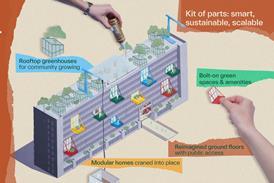The government claims there are only 190 homes in multiple occupation. Rather than trying to hide the true number why not encourage high quality homes for sharing, asks Julia Park

Most students experience the highs and lows of flat- or house-sharing. I shared a series of pretty squalid houses; first in Cardiff where I studied, and then in London when I started work. Even with mostly pretty good flat mates, eight years of sticky floors, washing up before cooking as well as after, queuing for the bathroom and being subjected to music I hated was more than enough.
This was the late seventies/early eighties. Desperate to be on my own and having managed to save £1,500 for a deposit on a flat I booked an appointment with the building society. I was told to come back when I’d doubled it. My parents weren’t in a position to help so I moved to the smallest, cheapest room I could find and went back a year later with £3,000 and a slightly higher salary. It was enough to buy the bottom half of a semi in Hounslow.
It couldn’t have come soon enough for me so the fact that so many young professionals are now sharing for decades rather than not years. The fact this is mostly not from choice is one of the most depressing outcomes of the housing crisis: made worse by the fact that so many have to put up with sub-standard accommodation. Calls for lower rents and better licensing, with renewal contingent on passing an annual inspection, are mounting, and rightly so.
But you have to find them first as shared houses and apartments are rarely marketed, or referred to as Homes in Multiple Occupation (HMO’s) though of course that’s what they are. A HMO is defined as having at least three tenants sharing a toilet, bathroom or kitchen under one roof. Clearly a large and growing number of homes are being occupied as HMOs but it’s remarkably difficult to find out how many – in response to a 2013 Freedom of Information request, the ONS said it didn’t collect this data in the ten yearly census.
Strange, because the government did have a dataset of housing types. The most recent I could find was April 2011. That put the number of ‘verifiable’ HMOs in England at 83,332 and the estimated number at 426,834 – over five times more.
In 2013-14 the National HMO Network, made up of local authorities, environmental health officers and landlords, suggested that there were 543,000 HMOs in England in 2013-14 and that the number was rising. But responding to another FOI request, this time in 2015, the government confirmed that the number of Council Tax properties classed as HMOs was just 190.
It is inconceivable that the number dropped from half a million to 190 in a year, and very likely that the real figure is much higher than even the HMO Network suggested. The vast majority don’t have to be licenced and in 2010 the law was changed to allow small HMOs’ which are planning use class C4 to be interchangeable with C3 (dwelling houses). The classification is intended to reflect the actual use of a house at a given point in time. But as most landlords prefer not to describe their rental properties as HMOs, the vast majority are declared as C3 if anyone even bothers to ask.
Whatever the real stats are, it’s pretty clear that the government isn’t keen to shout about it. Firstly, they simply don’t know and secondly, facing up to the full facts would reveal that housing need is even greater that even worse case scenarios suggest. Under the government’s own definition, all of the hidden HMOs currently recorded as single family homes are home to at least two households; on average, probably more like four. As we know, the vast majority of tenants are frustrated, aspiring homeowners.
Rather than pretend it’s not happening, wouldn’t it be better to face up to the reality of having to share and provide something better? Yes, our larger cites do now offer, new, good quality Build to Rent developments, some of which are designed for sharers. Manchester seems to be the new capital of build to rent homes but its shiny new flats are very expensive – out of reach to the majority of most sharers. Even the new ‘shared living’ models – micro flats supported by communal spaces – are too expensive for a typical HMO sharer. Those who can afford it rarely manage to save at the same time so they make little headway in the housing market. And both options tend to be large, somewhat anonymous, commercial developments that appeal to some but not all.
I’m convinced there’s a more affordable, more characterful, less institutional and better quality purpose-built solution that could be integrated into any normal street and look and feel more like home. Why not build some large houses (up to five storeys) with shared living, dining, kitchen and utility space at ground level. Integrate secure cycle storage into an extended porch and provide a small paved garden at the back. Put two large ensuite bedrooms on each of the upper floors with plenty of storage, a desk and really good soundproofing and add a roof terrace. Split what would be a fair market rent for a similar size family home between the tenants and it needn’t cost more than £400 a month for singles and £550 for couples, even in London.
I’ve tested two options and, on paper, they work really well. For those who can afford it, each floor could be one self-contained studio instead of two ensuite rooms and the shared spaces used differently – a shared workspace and home gym for example.
And sharing needn’t just be for young people. Co-living is gaining traction among older singles and it’s easy to see why. With the right scale of building, the right balance of private and shared space, and the right group of people, living alone suddenly becomes much less lonely. Let’s be more honest and more creative and look at making sharing an affordable and amiable option of choice.
















No comments yet